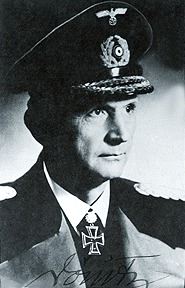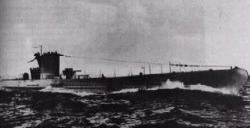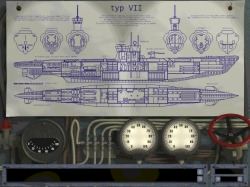| Silent Hunter II Interview by Leonard "Viking1" Hjalmarson |
||||
|
CSIM: I remember the first time I went up to the bridge on a moon-lit night in the South Pacific. WOW! I remember thinking later that if a seal had crawled to the side of the boat I wouldn't have been surprised! Will there be this much attention to the environment in SH II? A: There will be the same level of attention to detail. We'll be upgrading most of the effects from Silent Hunter while adding quite a few new ones. Silent Hunter II will use 16-bit color, allowing far better color effects.  Admiral Doenitz. We plan on completely revamping the visibility and hazing routines to allow for realistic low visibility weather conditions. In Silent Hunter, under low visibility conditions, ships would simply "pop" into view. The larger palette and better hardware available now makes it possible for us to create a smooth and realistic transition from non-visible to fully visible. Ships will slowly appear out of the haze. This is but one example of the improvements we plan on making to the original graphics engine. CSIM: What will be the maximum resolution of the graphics engine? A: The game will support two resolutions, hi-res(800x600) and low-res(640x480). CSIM: Tell us about object modeling, external as well as internal. We saw some great interiors in Silent Hunter, but they had a static, artwork feel to them. A: The ships are beautiful. The Aeon crew has done a great job giving the ships a realistic, weathered look. (The Aeon crew has one of the artist's from WW2 Fighters).
Ultimation (DC) and Aeon (SHII) are showing each other their progress and working well together. One thing we will have is cheat views, so there is an underwater view available. It's really cool, and even the murkiness of the water varies. If you are making an approach underwater you will have access to an outside view of your sub, even while launching torpedos. CSIM: Wow. Like a custom on-the-fly cut scene… A: No one has done this before, and it is REALLY cool. CSIM: Silent Hunter allowed us to actually sail into port, and view the buildings on shore as well as take shots at ships at anchor. How will this environment change graphically as well as tactically for SH2? A: These missions will be difficult, but you will see more interactivity and detail in these missions. We are going to take the things we learned from the first sim and take it to a new level. It will be familiar, yet better with more functionality. CSIM: Will SH2 model weather, and if so how will this impact tactics, resupply etc.? A: Yes. Water effects have to be in place because of the sea. Weather effects will be in place. You may see storms, but these things are still in discussion. |
 Courtesy of Tim Burton. CSIM: In 1944 the Germans built ninety Type 21 Electric Boats, by far the most significant advance in naval platforms during the war. Have you wondered why the Type 21 was never deployed? What have you discovered? A:The reasons for the Type XXI's slow introduction as well as its possible impact are a ripe subject for a large, controversial book! I'm not sure I'm qualified to write it! Only four Type XXI's were ready by January 1945 and a few actually began to sail from Kiel to Norway toward April. U2511 commanded by Adalbert Schnee made a practice approach on a British cruiser in May, withheld fire, and returned home. For me, this type of boat is intriguing not just because of its own capabilities and possible impact on the war, but also by imagining what kind of response the Allies would have made to it both technologically and tactically.
The Type XXI had a hydraulic torpedo reload system that enabled the commander to reload all 6 tubes in something like 10 minutes which was even less than it took to reload one tube on the Type VIIC. Three times the electrical power of the VIIC gave the Type XXI enormous underwater range compared to the older types. It took the boat 3-5 hours to re-charge the batteries with the Schnorchel once every 2-3 days if travelling at moderate 4-8 knots, and thus there was much less danger from aircraft, which sank about 56% of all U-boats lost in the war. The maximum submerged speed was 17 knots and could be maintained for 60-80 minutes. At the silent submerged cruising speed (5 knots) the Type XXI had to schnorkel for only 3 hours a day to keep the batteries charged. The radar-search receiver Tunis fitted to schnorkel and anti-radar rubber coating offered additional safety. Even when located, an alteration of speed and course would help to evade escorts or aircraft-dropped sonar buoys. When escaping at high speed, the Type XXI was almost as fast as the Allied escorts, and bubbling of water rushing along the hull would make ASDIC location difficult. The potential area where a hunted Type XXI, escaping at the silent speed of 5 knots, would be forced to raise the schnorkel again was some 10-13 times greater (365 miles) than the area for a conventional U-boat (escaping at 2 knots with a range of 100 miles). Source: U-boat Net.
CSIM: Will Silent Hunter II allow us to play with history and take to the seas in the Type 21? A: Type XXI's will be included in Silent Hunter II. If the campaign is played with high realism settings, odds are you will receive a Type XXI very late in the war and only for trials (as really occurred). On less realistic levels, they may appear earlier and see combat in the campaign. Go to Part IV
|
|||
|
© 1997 - 2000 COMBATSIM.COM, INC. All Rights Reserved. Last Updated February 10th, 1999 |
||||


